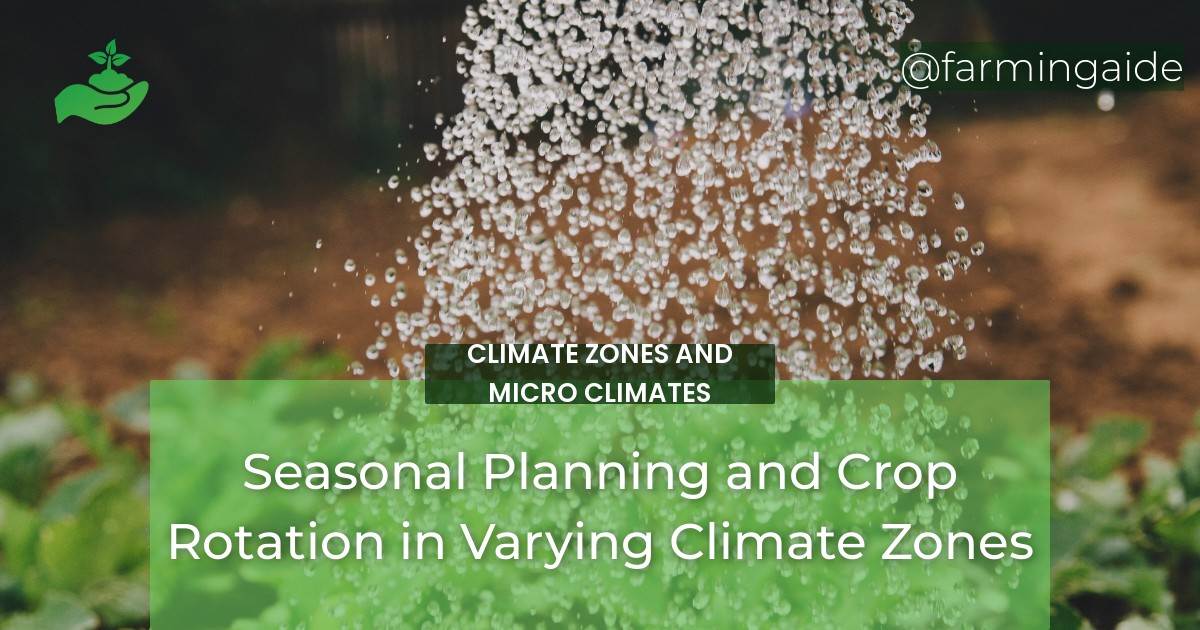Seasonal planning and crop rotation are essential practices in the world of urban farming and horticulture. These techniques involve carefully planning and rotating crops based on the changing seasons and varying climate zones. As a SEO expert, I understand the importance of these practices in improving page rank and achieving higher visibility in the SERPs. In this article, we will delve into the details of seasonal planning and crop rotation in different climate zones, and how they can benefit your urban farming and horticulture endeavors.
Definition of Seasonal Planning and Crop Rotation
Seasonal planning is the process of strategically selecting and planting crops based on the changing seasons. This involves understanding the climate and weather patterns of a specific region and choosing crops that are best suited for each season. Crop rotation, on the other hand, is the practice of alternating the types of crops grown in a specific area to improve soil health and prevent the buildup of pests and diseases.
Benefits of Seasonal Planning and Crop Rotation
There are numerous benefits to incorporating seasonal planning and crop rotation in your urban farming and horticulture practices. Some of these include:
- Maximizing crop yield and quality
- Improving soil health and fertility
- Reducing the risk of pests and diseases
- Conserving water and other resources
- Promoting biodiversity
Impact of Climate Zones on Seasonal Planning and Crop Rotation
The climate zone of a specific region plays a crucial role in determining the success of seasonal planning and crop rotation. Different climate zones have varying weather patterns, which can greatly affect the growth and development of crops. It is important to understand the characteristics of each climate zone and how they can impact your seasonal planning and crop rotation strategies.
Tips for Effective Seasonal Planning and Crop Rotation
Understanding Climate Zones and Their Characteristics
Before embarking on seasonal planning and crop rotation, it is important to understand the different climate zones and their characteristics. This will help you choose the right crops for each season and make necessary adjustments to your crop rotation plan.
Factors to Consider when Planning for Different Climate Zones
When planning for different climate zones, there are several factors to consider, including:
- Temperature and humidity
- Length of growing season
- Soil type and fertility
- Water availability
- Local pests and diseases
ALSO READ
Best Practices for Seasonal Planning in Varying Climate Zones
To ensure successful seasonal planning in varying climate zones, here are some best practices to keep in mind:
- Research and choose crops that are best suited for each season and climate zone
- Plan for succession planting to extend the growing season
- Use season extenders, such as greenhouses or row covers, to protect crops from extreme weather
- Implement crop rotation to maintain soil health and prevent pest and disease buildup
Importance of Crop Rotation in Different Climate Zones
Crop rotation is a crucial aspect of successful urban farming and horticulture in different climate zones. It helps maintain soil health and fertility, prevents pest and disease buildup, and promotes biodiversity. By rotating crops, you can also take advantage of the unique characteristics of each climate zone and maximize your crop yield and quality.
ALSO READ
Selection of Crops for Each Season in Different Climate Zones
When selecting crops for each season in different climate zones, it is important to consider the specific requirements and characteristics of each crop. Some crops may thrive in cooler temperatures, while others may require more sunlight. It is also important to choose crops that complement each other in terms of soil nutrient needs and pest and disease resistance.
Tips for Successful Crop Rotation in Different Climate Zones
To ensure successful crop rotation in different climate zones, here are some tips to keep in mind:
- Rotate crops based on their families to prevent the buildup of pests and diseases
- Include cover crops in your rotation plan to improve soil health and fertility
- Monitor soil nutrient levels and make necessary adjustments to your crop rotation plan
- Keep detailed records of your crop rotation plan to track the success of each season
Sustainable Gardening Practices for Varying Climate Zones
In addition to seasonal planning and crop rotation, there are other sustainable gardening practices that can benefit urban farming and horticulture in varying climate zones. These include composting, water conservation, and using organic pest and disease control methods.
How Do Different Climate Zones Affect Seasonal Planning and Crop Rotation in Gardening?
Different climate zones greatly impact seasonal planning and crop rotation in gardening. In warmer climates, multiple growing seasons allow for more extensive crop rotation. In contrast, cooler climates with shorter growing seasons require careful seasonal planning and crop rotation to maximize productivity and soil health.
Conclusion
In conclusion, seasonal planning and crop rotation are crucial practices for successful urban farming and horticulture in different climate zones. By understanding the characteristics of each climate zone and implementing best practices for seasonal planning and crop rotation, you can maximize your crop yield and quality, improve soil health, and promote sustainable gardening practices. Incorporate these techniques into your urban farming and horticulture endeavors and see the positive impact on your crops and the environment.
Summary of the Importance of Seasonal Planning and Crop Rotation in Different Climate Zones
Seasonal planning and crop rotation are essential practices for urban farming and horticulture in different climate zones. They help maximize crop yield and quality, improve soil health, and promote sustainable gardening practices.
Final Thoughts and Recommendations
As an SEO expert and urban farming and horticulture industry expert, I highly recommend incorporating seasonal planning and crop rotation into your gardening practices. By understanding the impact of climate zones and implementing best practices, you can achieve success in your urban farming and horticulture endeavors. Remember to always prioritize sustainability and make necessary adjustments to your plan based on your specific climate zone and crop needs.
RELATED ARTICLES:


